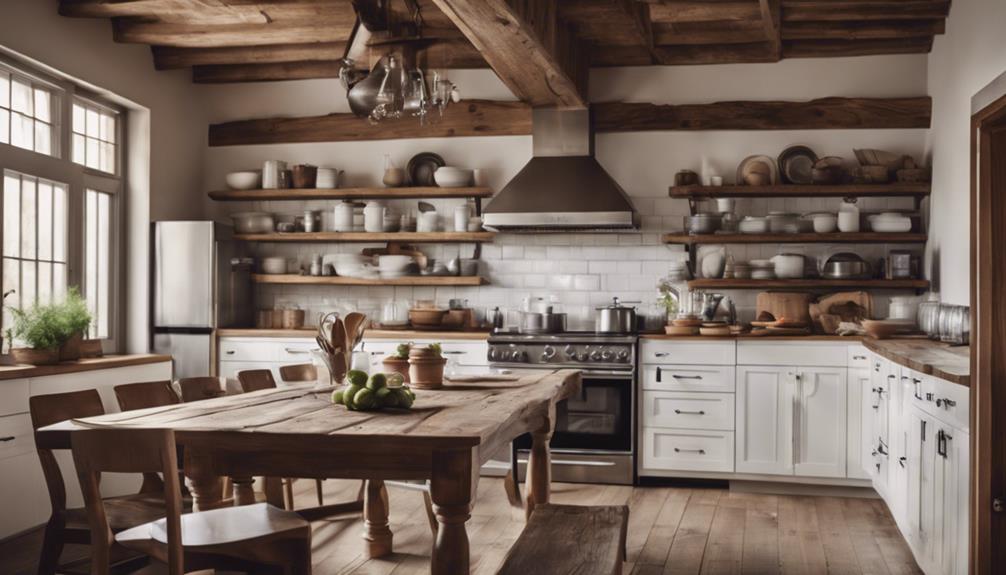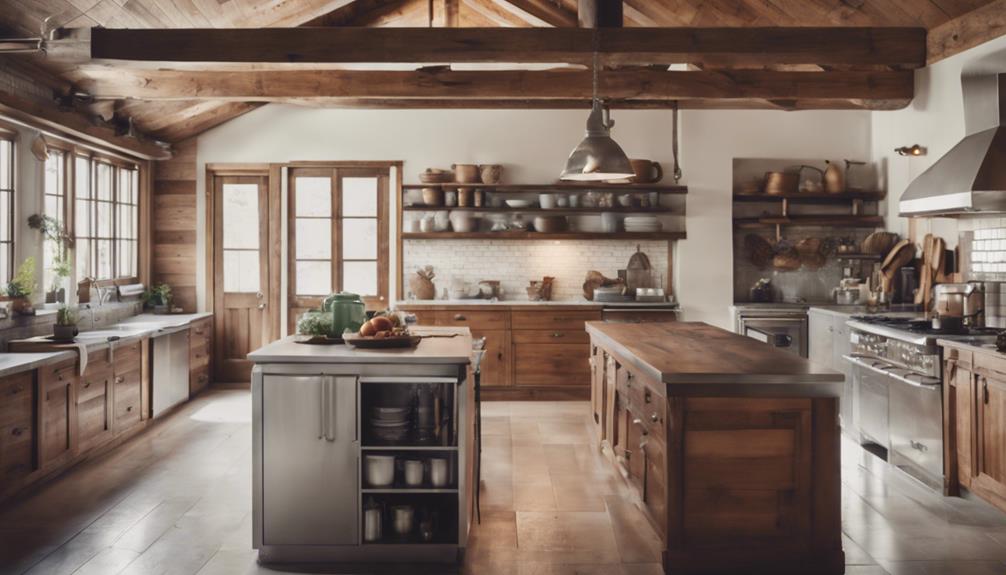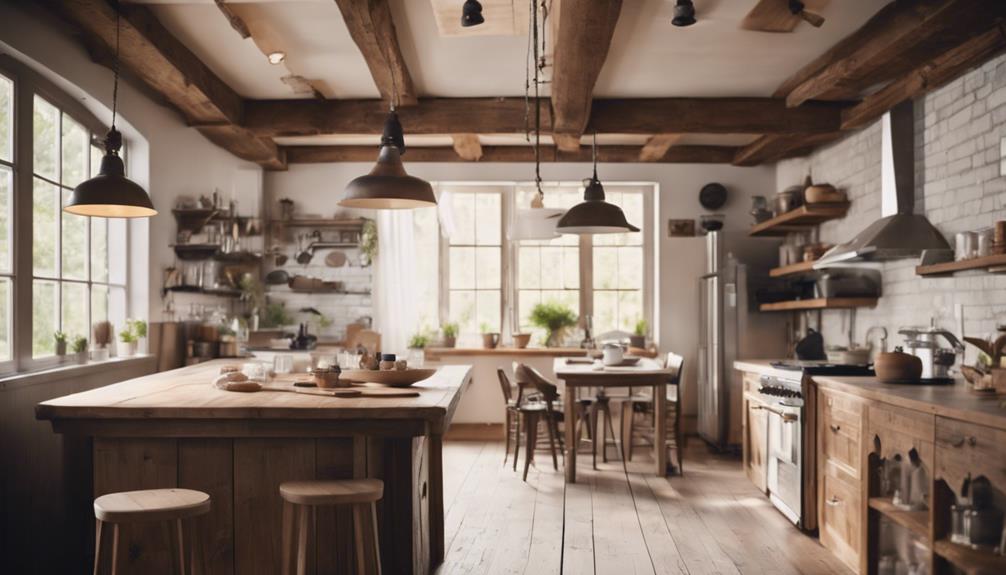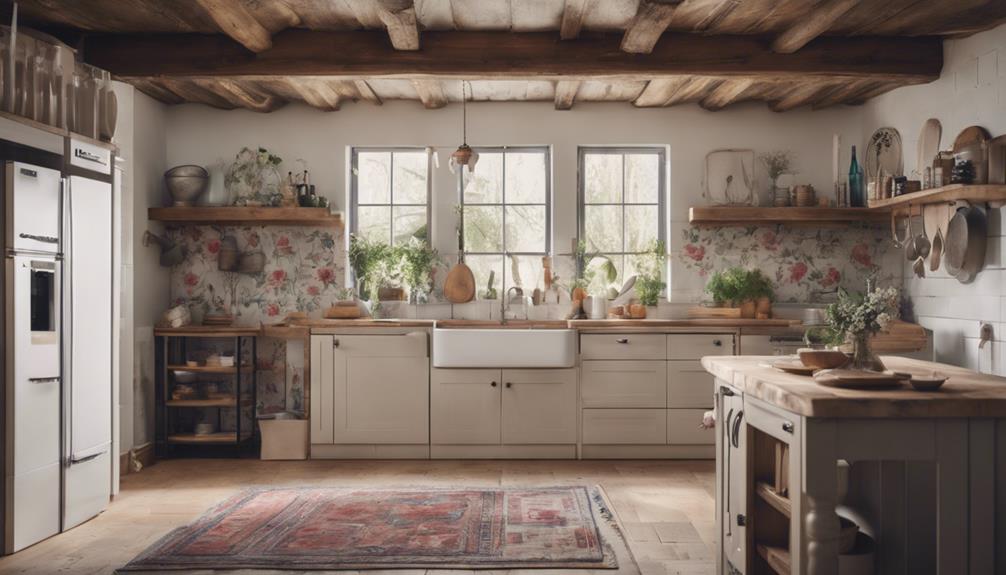When deciding between modern and traditional styles for your country kitchen, it’s important to consider how each option fits with your lifestyle. Traditional kitchens provide a cozy and inviting atmosphere with natural materials and a rustic charm, featuring soft colors and vintage fixtures. On the other hand, modern designs focus on sleek lines, neutral palettes, and minimalistic aesthetics, incorporating bold accents for a fresh look. Both styles prioritize functionality, so the choice ultimately comes down to whether you prefer a cozy and inviting space or a clean and contemporary one. Explore key elements such as lighting, fixtures, and flooring to achieve the perfect balance for your kitchen and determine which style best aligns with your vision.
Key Elements

When designing your country kitchen, focusing on the right color scheme, materials, and textures is essential.
These elements not only set the tone for the space but also reflect your personal style.
Let's explore how each of these aspects can bring your vision to life.
Color Scheme
Choosing the right color scheme for your country kitchen sets the tone for the entire space, blending warmth and style to create an inviting atmosphere.
In traditional kitchens, you'll typically find warm, earthy colors like soft pastels, cream, and muted greens or blues. These hues foster a cozy feel, perfect for family gatherings. To enhance the color palette, natural materials like wood and stone add organic textures and tones that complement the overall design.
On the other hand, modern design leans towards a more neutral palette, incorporating whites, grays, and beiges. Bold accents in colors such as navy blue or forest green can create a striking contemporary feel. In this style, it's common to see simpler patterns or solid colors in textiles, keeping the look minimalistic and fresh.
Lighting also plays an essential role in defining your color scheme. Traditional kitchens often feature ornate pendant lights in warm metals, while modern kitchens might opt for sleek fixtures in matte black or chrome.
Materials
In a country kitchen, the choice of materials plays a crucial role in achieving that warm, inviting atmosphere synonymous with rustic charm. You'll want to focus on natural materials like wood, stone, and brick, which create a cozy feel.
For cabinetry choices, traditional styles such as Shaker or farmhouse designs are ideal. These often feature distressed finishes or rich wood tones that enhance the overall aesthetic.
When it comes to countertop options, consider durable materials like butcher block, granite, or quartz. These not only provide functionality but also align beautifully with traditional design elements.
Flooring preferences typically lean toward natural wood or tile, offering durability while complementing the country theme.
Don't overlook appliance styles, either. Vintage-inspired appliances, like retro refrigerators and farmhouse sinks, seamlessly blend modern functionality with traditional aesthetics, making them a perfect fit for your country kitchen.
Textures
Embracing a variety of textures is essential for crafting the inviting and cozy atmosphere that defines a country kitchen. In traditional kitchens, you'll often find natural textures like wood, stone, and brick, which create a warm and welcoming environment. These elements emphasize comfort and charm, making them a staple in country kitchen design.
In contrast, modern kitchens incorporate sleek stainless steel appliances paired with rustic wood accents, blending contemporary sophistication with traditional warmth. This combination brings a fresh yet familiar feel to the space. You can also enhance the nostalgic texture by incorporating vintage-inspired fixtures and appliances, adding a sense of history and personal touch.
Open shelving is another effective way to showcase textured dishware and decorative items, enriching your kitchen's character. Layering different textures, such as soft fabrics for curtains alongside natural materials, creates a cozy and eclectic aesthetic. This approach allows you to express your style while maintaining the inviting nature typical of country kitchens.
Whether you lean towards traditional or modern, thoughtful texture choices will guarantee your kitchen feels warm and welcoming.
Essential Fixtures and Furniture

When designing your country kitchen, essential fixtures and furniture play a vital role in achieving that cozy vibe.
Think about incorporating a farmhouse sink with an apron front for a touch of rustic charm, paired with a vintage pendant light fixture to enhance the ambiance.
A reclaimed wood dining table not only adds warmth but also creates a perfect gathering space for family and friends.
Farmhouse Sink With Apron Front
A farmhouse sink with an apron front adds both charm and practicality to your country kitchen, making it a must-have fixture for any home chef. These sinks are characterized by their deep basin and exposed front, which not only enhances the aesthetic but also offers functionality that's perfect for busy kitchens.
You'll find farmhouse sinks made from durable materials like fireclay, stainless steel, or cast iron, guaranteeing they stand the test of time. In traditional kitchens, this sink style creates a welcoming ambiance, inviting you and your guests to gather around.
The apron front design allows for easier access, which is especially handy when you're washing large pots and pans. Plus, with a variety of colors and finishes available, you can easily match a farmhouse sink to your kitchen decor, whether you prefer a modern twist or a classic look.
Keep in mind that installing a farmhouse sink may require specific cabinetry adjustments due to its unique size and depth. Consulting a professional can help guarantee a perfect fit and ideal functionality, making it a worthwhile investment for your kitchen's heart.
Vintage Pendant Light Fixture
Adding a vintage pendant light fixture can elevate your country kitchen's charm, just like a farmhouse sink with an apron front enhances its practicality. These vintage pendant light fixtures serve as stylish focal points, seamlessly blending functionality with aesthetic appeal. Their warm, inviting illumination creates an inviting atmosphere, perfect for both casual family meals and elegant dinner parties.
Often featuring distressed finishes or intricate designs, these fixtures echo the rustic charm of traditional country kitchens, enhancing your kitchen's overall design theme. Available in various materials like wrought iron, glass, and wood, vintage pendant lights complement other vintage or farmhouse elements commonly found in country kitchen decor.
When choosing your vintage pendant lights, consider the size and number required to guarantee they fit proportionately in your space. Installing them at the right height is essential for effective lighting. For added versatility, opt for dimmable options that allow you to adjust the ambiance according to the occasion.
Reclaimed Wood Dining Table
Transform your country kitchen with a reclaimed wood dining table that not only showcases rustic charm but also embodies sustainability by repurposing old materials.
These tables are perfect for creating a cozy and welcoming atmosphere, making them a staple in any traditional kitchen design. Each piece features unique grain patterns and imperfections, ensuring your table is a one-of-a-kind centerpiece that enhances your kitchen style.
Reclaimed wood is often more durable than new wood, thanks to its age and density, providing a sturdy option for everyday use. You'll appreciate the rich, warm tones that complement the inviting feel of your country kitchen, ideal for family gatherings and meals.
Plus, the maintenance is straightforward—regular cleaning and occasional oiling or waxing will keep your table looking beautiful for years to come.
Incorporating a reclaimed wood dining table into your kitchen not only elevates the aesthetic but also reflects your commitment to sustainability.
Lighting Ideas

When it comes to lighting your country kitchen, you'll want to balance charm and functionality.
Think about adding rustic lanterns or vintage Edison bulb fixtures to create a warm atmosphere.
Don't forget to contemplate under-cabinet LED strip lights and rustic wall sconces for a touch of elegance and practical illumination.
Charming Rustic Lanterns
Charming rustic lanterns create a warm and cozy ambiance in your country kitchen, enhancing its inviting atmosphere with their vintage-inspired design. These lanterns, often made from natural materials like wrought iron, distressed wood, and glass, add a touch of charm that complements the rustic kitchen style you desire.
When you choose rustic lanterns, consider various sizes and styles to fit your existing decor. Whether you opt for pendant, wall-mounted, or freestanding options, each style can serve as a focal point or subtle accent. Dimmable lanterns are particularly useful, allowing you to adjust the lighting effortlessly for cooking or entertaining.
To create a cohesive look in your space, combine your lanterns with other decorative elements. Open shelving, for instance, can showcase your favorite dishes while enhancing the overall aesthetic.
Vintage Edison Bulb Fixtures
How can vintage Edison bulb fixtures elevate the ambiance of your country kitchen while providing warm, inviting light? These fixtures bring a nostalgic charm that perfectly complements the rustic aesthetics of your space.
With their exposed filaments, they not only enhance the vintage look but also serve as a stunning focal point in your kitchen. Available in various shapes and sizes, Edison bulbs can be customized to fit your design needs, whether you prefer pendant lights hanging over the island or an elegant chandelier.
The warm glow emitted by these bulbs beautifully enhances the natural materials in your kitchen, like wood and stone, creating a cozy atmosphere that's perfect for cooking and entertaining.
Additionally, incorporating dimmable Edison bulb fixtures adds versatility to your lighting. You can easily adjust the brightness for different activities—bright task lighting for meal prep or soft ambient light for intimate gatherings.
Under-Cabinet LED Strip Lights
While vintage Edison bulb fixtures add character to your country kitchen, under-cabinet LED strip lights enhance both functionality and ambiance with their energy-efficient illumination.
These lights consume up to 75% less energy than traditional incandescent bulbs, making them an eco-friendly choice for your kitchen. They create a warm, inviting atmosphere that complements the cozy vibe of traditional kitchens while also improving visibility for food preparation tasks.
Available in various color temperatures, you can opt for warm white (2700K-3000K) to maintain a classic feel, or cooler tones (4000K-5000K) for a more modern aesthetic.
The easy installation and customizable lengths of under-cabinet LED strip lights allow you to tailor them to fit your kitchen layout perfectly, whether you lean towards modern or traditional styles.
Additionally, many of these lights come with dimmable options and smart technology compatibility, letting you adjust brightness and color settings to suit different moods and occasions.
With under-cabinet LED strip lights, you'll not only embrace energy-saving illumination but also create a functional and stylish space that reflects your personality.
Rustic Wall Sconces
Rustic wall sconces bring warmth and character to your country kitchen, enhancing the inviting atmosphere with their vintage-inspired designs.
These fixtures often feature materials like wrought iron, wood, or aged metal, which perfectly complement the natural elements commonly found in traditional kitchens. You'll find that lantern-style or candle-style sconces add a charming touch, making your kitchen feel cozy and welcoming.
When placing rustic wall sconces, consider strategic locations that provide ambient lighting. This helps create a warm and inviting atmosphere for family gatherings or cooking activities. Many sconces come in earthy tones, such as rich browns, greens, or muted metals, allowing them to blend seamlessly with your kitchen's decor.
Moreover, the versatility of dimmable rustic sconces can't be overlooked. You can easily adjust the brightness to suit any occasion, from casual meals to more formal gatherings.
Decorative Elements

When it comes to decorative elements in your country kitchen, think about adding a handcrafted ceramic vase for a personal touch.
An antique wooden spice rack can't only serve a practical purpose but also enhance the rustic vibe.
Handcrafted Ceramic Vase
Handcrafted ceramic vases add a unique touch of artisanal charm to your country kitchen, enhancing its cozy and inviting atmosphere. These vases often showcase intricate decorative molding and vibrant glazes, making each piece a true work of art. When you choose a handcrafted ceramic vase, you bring a one-of-a-kind element into your space, perfectly complementing the warm, rustic feel typical of traditional kitchens.
Incorporating floral arrangements into these vases can introduce natural colors and delightful scents, further enriching the welcoming atmosphere of your kitchen. The use of earthenware or stoneware in these vases harmonizes beautifully with other natural materials like wood and stone, creating a cohesive look that resonates with country living.
Moreover, handcrafted ceramic vases aren't just visually appealing; they serve practical purposes too. You can use them to hold kitchen utensils or fresh herbs, blending functionality with decorative appeal.
Antique Wooden Spice Rack
An antique wooden spice rack brings a warm, inviting charm to your country kitchen, serving as both a practical storage solution and a fascinating decorative element. Typically crafted from natural wood, these antique spice racks showcase intricate detailing and vintage craftsmanship that enhance the rustic authenticity of traditional kitchens.
Whether wall-mounted or freestanding, an antique spice rack provides functional storage for your spices, herbs, and small kitchen items while doubling as a decorative display. Its presence can evoke nostalgia and a sense of history, making it a perfect focal point that invites conversation and storytelling.
Incorporating this piece allows you to blend modern convenience with traditional elements, creating a unique and personalized kitchen space. You can easily access your spices while enjoying the charm of a bygone era. Additionally, the warm hues of the wood complement various color palettes and styles, enhancing the overall aesthetic of your kitchen.
Choosing an antique wooden spice rack not only elevates the look of your kitchen but also adds character and functionality, making it a worthwhile investment in your home's decor.
Vintage Wall Art Piece
Vintage wall art pieces infuse your country kitchen with charm and character, creating a welcoming atmosphere that invites warmth and nostalgia.
Whether you choose rustic paintings or antique signs, these decorative elements enhance the overall aesthetic of traditional kitchens. Incorporating framed botanical prints or farmhouse-themed artwork not only evokes a sense of nostalgia but also connects you to traditional craftsmanship.
As you curate your space, consider creating a gallery wall featuring a mix of vintage art. This approach showcases your personal preferences while adding visual interest and serving as a focal point in the kitchen.
Opting for repurposed materials, such as reclaimed wood frames, aligns beautifully with the country kitchen's emphasis on natural elements and sustainability.
Plus, vintage wall art offers an affordable way to personalize your kitchen without extensive renovations. You can transform your space with unique pieces that tell a story and reflect your style.
Ultimately, vintage wall art not only enhances the charm of your country kitchen but also creates a timeless atmosphere that you and your guests will love.
Flooring

When it comes to flooring in your country kitchen, you've got some great options to evaluate.
Wide-plank reclaimed hardwood adds a rustic charm, while textured stone tile can bring a natural feel to the space.
If you're looking for something unique, cement tile with a patterned design can make a bold statement and elevate your kitchen's style.
Wide-Plank Reclaimed Hardwood Flooring
Choosing wide-plank reclaimed hardwood flooring not only adds rustic charm to your country kitchen but also promotes eco-friendliness by utilizing salvaged materials. This flooring option features planks that range from 5 to 12 inches in width, creating a spacious and inviting atmosphere that beautifully complements both modern and traditional kitchens.
Reclaimed hardwood is celebrated for its durability and unique character, with each plank telling a story from its past life. This distinctiveness enhances the authenticity of your space, making it an appealing choice for buyers who value sustainability and originality in home design.
Additionally, opting for wide-plank reclaimed hardwood flooring can elevate the overall value of your kitchen, as it's a sought-after feature in today's market. While maintenance requires regular cleaning and occasional refinishing, it's well worth the effort, especially in high-traffic areas like kitchens.
Textured Stone Tile Flooring
Textured stone tile flooring brings rustic charm and durability to your country kitchen, making it perfect for busy households. This flooring option not only enhances traditional kitchens but also fits seamlessly into modern kitchen design styles. The natural variations in color and texture of stone tiles create a unique aesthetic that warms up the space, inviting family and friends to gather.
One of the standout features of textured stone tile flooring is its low maintenance and high durability, making it ideal for high-traffic areas. Available in various finishes like honed, polished, or tumbled, you can choose a style that suits your preferences and desired slip resistance. This versatility allows you to achieve the perfect look, whether you lean toward a classic or contemporary vibe.
Additionally, stone flooring is energy-efficient; it retains heat during colder months while feeling cool underfoot in warmer climates. With proper installation and sealing, textured stone tile flooring can last for years, making it a worthwhile investment for anyone looking to create a timeless and inviting atmosphere in their country kitchen.
Consider this flooring choice to elevate your space while enjoying its practical benefits.
Cement Tile With Patterned Design
Cement tiles with patterned designs offer a vibrant and durable flooring option that brings character to your country kitchen. Known for their resilience, these cement tiles can withstand the wear and tear of high-traffic areas, making them ideal for busy households. You'll find a vast array of colors and intricate patterns, allowing you to create a personalized aesthetic that complements either modern or traditional styles.
However, it's important to remember that the porous nature of cement tiles requires proper sealing to prevent staining and moisture damage. This small step guarantees longevity while maintaining the beauty of your chosen design. Additionally, maintaining these tiles is a breeze; a simple mix of mild detergent and water is all you need to keep them looking fresh.
With a thickness ranging from 1/2 inch to 1 inch, cement tiles provide a solid feel underfoot, enhancing the rustic charm typical of country kitchens. By choosing patterned designs, you can elevate your kitchen's appeal and create a unique space that reflects your personality. Embrace the versatility of cement tiles and transform your country kitchen into a stylish and functional area.
How Can I Incorporate Modern Elements into My Traditional Country Kitchen Design?
When blending country contemporary styles into your traditional country kitchen, consider adding sleek, modern appliances alongside rustic, vintage decor. Play with mixing materials like wood and stainless steel or incorporating minimalist touches like clean lines and neutral colors. This will create a harmonious balance between old and new in your kitchen design.
Conclusion
Ultimately, choosing between modern and traditional styles for your country kitchen comes down to your personal taste and lifestyle.
If you love clean lines and sleek finishes, modern might be your best bet.
However, if you're drawn to warmth and rustic charm, traditional may be the way to go.
Whichever style you choose, make sure it reflects who you are and creates a space that feels like home.
Happy decorating!









